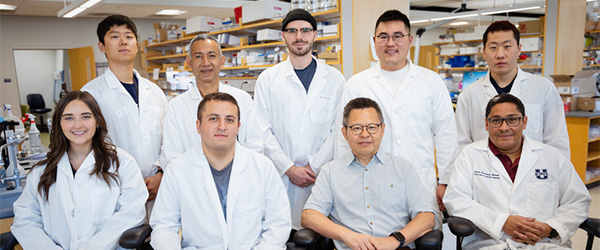
Scientists at Utah State University Receive Grants to Study Two Important Viruses
October 10, 2024
Researchers at Utah State University, led by Professor Zhongde Wang and collaborating with teams at University of Texas Medical Branch and University of Pittsburgh, respectively, have secured two grants from the National Institutes of Health (NIH) totaling more than $4 million in recent months to advance the understanding of two important global health threats. In these research collaborations, Wang and his lab bring critical knowledge and skills in gene editing.
In both new projects, on which Wang is a principal investigator, funding supports the development and use of specialized, gene-edited golden Syrian hamsters. Wang and his USU team successfully used CRISPR-Cas9 gene editing technology to produce the first of the hamsters a decade ago and the lab’s contributions have proven to be an important advancement in the creation of safe and effective treatments and vaccines.
A critical early step in developing therapeutic drugs and vaccines that can treat or prevent the spread of virus infections is to discover how a specific virus enters certain types of cells and essentially hijacks the cell to produce new virus particles. Think of a virus’s surface proteins as a key that fits specific receptors on a cell’s surface and can “unlock” the cell so the virus can enter and replicate.
Some of these interactions can be investigated in a lab, but bodies are complex systems and what works in a Petri dish and in traditional rodent models frequently doesn’t work the same way in humans. Wang’s lab produced the first hamsters with specific human genes that cause cells to behave more like human ones as they react to virus infections.
In addition to conducting cutting-edge research, Wang, a professor in USU’s Department of Animal, Dairy and Veterinary Sciences, is also a dedicated mentor for young researchers. He encourages his research assistants, including undergraduate student researchers, to pursue biomedical research as a career because so much is unknown about the mechanisms of disease and opportunities to do important and useful work.
“Basic research is important, even though you don’t always see the end user at the start, but I think it’s not enough to feel established in one thing and just settle in and follow one trail,” Wang said. “Doing work that truly has an impact is what drives my research. I want to be a trailblazer. I have a very talented team and when they get recruited to a great job on a university’s faculty or to industry, I feel that is a success for me too.”
The two recent NIH grants that Wang’s lab is at work on focus on Chikungunya virus (CHIKV) and Hepatitis B virus (HBV).
Tackling Chikungunya: A Mosquito-Borne Threat
Chikungunya, a mosquito-borne RNA virus, causes severe fever and joint pain, which can often persist for months or even years. While the virus has been recognized since the 1950s, there has been a resurgence in recent years, spreading across Africa, Asia, Europe, and the Americas. Despite its significant impact, there are currently no antiviral treatments or vaccines available.
The new research aims to overcome the limitations of existing animal models that do not fully mimic the disease in humans, particularly the chronic joint pain and maternal transmission of the virus.
“We’ve already seen that wild-type hamsters respond to CHIKV infection in ways similar to humans, but the virus is cleared too quickly to study its long-term effects,” Wang said. “Our gene-edited hamsters, particularly those lacking specific immune responses, will help us explore how the virus persists in the body and causes chronic disease.”
This work will not only refine the animal model for CHIKV but also increase understanding of the virus’s interactions with the immune system, potentially leading to breakthroughs in treatments.
A New Model for Hepatitis B Research
The second research grant focuses on another pressing global health challenge: Hepatitis B. Over 296 million people live with chronic HBV infection, and while treatments exist, they rarely result in a full cure. Each year, the virus claims around 820,000 lives, often through complications like liver cancer and cirrhosis.
One of the main obstacles to finding a cure is the lack of animal models that can fully replicate the life cycle of the virus. The gene-edited hamster model will allow scientists to study both acute and chronic infections in ways that can bring them closer to understanding how to eradicate the virus from the body.USU’s Department of Animal, Dairy and Veterinary Sciences
“This breakthrough will allow us to study how the virus persists and how the immune system responds during both acute and chronic infection,” Wang explained. “By using this model, we can also test new antiviral drugs and immune-based therapies that have the potential to offer a functional cure for HBV.”
The research is poised to accelerate the development of new treatments, offering hope to millions worldwide who live with the chronic disease.
#####
Contact: Zhongde Wang, Zonda.Wang@usu.edu
Writer: Lynnette Harris, Lynnette.Harris@usu.edu, 435-797-2189